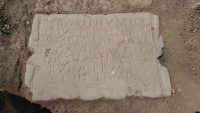 An intact Latin inscription has been unearthed in an excavation of the ancient Thracian city of Kabyle near modern-day Kabile in southeastern Bulgaria. It is the first complete Roman inscription discovered in Kabyle in 35 years, a notable gap in a city that had a strong Roman presence from its conquest in 71 B.C. until the Gothic invasions of the 4th century.
An intact Latin inscription has been unearthed in an excavation of the ancient Thracian city of Kabyle near modern-day Kabile in southeastern Bulgaria. It is the first complete Roman inscription discovered in Kabyle in 35 years, a notable gap in a city that had a strong Roman presence from its conquest in 71 B.C. until the Gothic invasions of the 4th century.
The marble slab engraved with the inscription is two feet high by 2.6 feet wide. The seven lines of Latin inscribed on the slab refer to the construction of the public baths between 166 and 169 A.D., during the reign of Emperor Marcus Aurelius (161-180 A.D.).
The Kabyle thermae were built by the Cohors II Lucensium (Second Lucensian Cohort), Roman military unit based in the Thracian city at the time. The unit was commanded by prefect (praefectus) named Elius Rufus.
The stone slab itself has been found near the principia (plural of principium), the building for the command staff of the respective Roman military unit.
“All in all, the inscription’s translation reveals that the thermae in Kabyle were built by the Cohors II Lucensium (Second Lucensian Cohort) at the time when the Thracia province was governed by Governor Claudius Marcialus,” Bakardzhiev has told the BNT TV channel.
Before the discovery of the slab, archaeologists didn’t know anything about the Second Lucensian other than that it arrived in Kabyle in 136 A.D. The inscription confirmed not only that the Second Lucensian built the baths under the command of Elius Rufus, but that the site of excavation was in fact the cohort’s principia.
This is only the fourth inscription found in Kabyle that provides concrete information about Roman building projects in the city. The baths, one of the most extensive public structures built in Roman Kabyle, didn’t even have a clear date of construction until the discovery of the inscription.